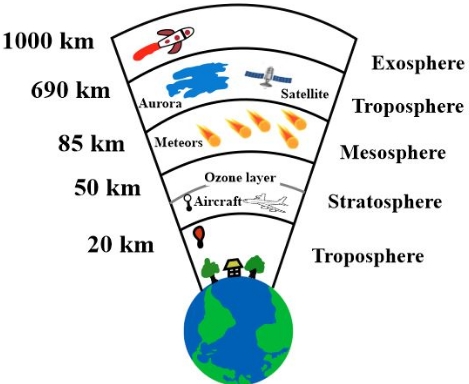
CBSE Class 7 Geography Notes Chapter 4: The term "air" refers to the general mixture of gases that make up the atmosphere of Earth. In addition to oxygen, water vapour, argon, carbon dioxide, and trace gases, this gas is mostly nitrogen. All living things need air to survive.
The CBSE Class 7 Geography chapter 4 on air provides a detailed explanation of the atmosphere's makeup, structure, weather, and climate, among other topics. We have created CBSE Class 7 Geography notes for Chapter 4 based on the ideas presented in the relevant chapter. Before writing the exam, it's a good idea to quickly review these notes.CBSE Class 7 Geography Notes Chapter 4 Overview
Chapter 4 of the CBSE Class 7 Geography syllabus covers the various facets, information, and ideas related to air. To thoroughly understand this chapter, students will need to take detailed notes. The subject matter experts have made it simpler by compiling the best notes to refer to and advance your study. Learn how to create responses by applying these notes to gain a thorough understanding of the subject. The common word for the mixture of gases that make up the Earth's atmosphere is air. The gas is primarily nitrogen, with trace gases, carbon dioxide, argon, and water vapour also present. One important component in the survival of living things is air. Students will understand the importance of air and how vital it is to our survival in this chapter.CBSE Class 7 Geography Notes Chapter 4 PDF
Here we have provided CBSE Class 7 Geography Notes Chapter 4 for the ease of students so that they can just download the pdf and use it easily without the internet. These CBSE Class 7 Geography Notes Chapter 4 will help students understand the chapter better.CBSE Class 7 Geography Notes Chapter 4 PDF
CBSE Class 7 Geography Notes Chapter 4
Here we have provided CBSE Class 7 Geography Notes Chapter 4 for the ease of students so that they can prepare better for their exams. Earth's atmosphere is the layer of air that envelops our globe. For their survival, all living things on Earth rely on the atmosphere. The earth's temperature is livable because of this quantity of air.Composition of the Atmosphere
Oxygen and nitrogen are present in large quantities in the atmosphere. Lesser amounts of hydrogen, argon, carbon dioxide, helium, and ozone are present. The air also contains microscopic dust particles in addition to these gases. The most prevalent gas in the atmosphere is nitrogen. A certain amount of nitrogen enters our lungs during inhalation and is exhaled. Plants require nitrogen to thrive. They cannot directly absorb nitrogen from the atmosphere. Some plants' roots and soil are home to bacteria that transform atmospheric nitrogen into a form that plants can use. The second most common gas in the atmosphere is oxygen. Both animals and humans breathe in oxygen from the surrounding air. Green plants make oxygen during the process of photosynthesis. The air's oxygen concentration stays constant in this way.Carbon dioxide is an additional significant gas. Carbon dioxide is used by green plants to produce food and oxygen. Either animals or humans emit carbon dioxide. There appears to be a perfect balance between the quantity of carbon dioxide that plants use and the amount that humans and other creatures release.
Structure of the Atmosphere
Beginning at the surface of the earth, five layers make up the atmosphere. The mesosphere, Exosphere, Troposphere, Stratosphere, and Thermosphere are these. The atmosphere's most significant layer is called the troposphere. The air we breathe is found here, and its average height is 13 kilometres. All-weather phenomena like hail, fog, and rain happen in this layer. Stratosphere: The stratosphere is located above the troposphere. It reaches a height of fifty km. This layer is perfect for aircraft flight since it is devoid of clouds and related meteorological events. There is an ozone gas layer on it.
The third layer of the atmosphere is called the mesosphere. Above the stratosphere, it is located. It reaches a height of eighty km. As meteorites enter this layer from space, they burn up.
Thermosphere: As altitude increases, temperatures in the thermosphere climb quite quickly. This layer includes the ionosphere. It spans a distance of 80–400 km. Radio transmission is aided by this layer. In actuality, this layer reflects the earth radio waves that are broadcast from it.
Exosphere: The term exosphere refers to the topmost layer of the atmosphere. There's very thin air in this layer. From here, light gases such as hydrogen and helium drift into space.
Stratosphere: The stratosphere is located above the troposphere. It reaches a height of fifty km. This layer is perfect for aircraft flight since it is devoid of clouds and related meteorological events. There is an ozone gas layer on it.
The third layer of the atmosphere is called the mesosphere. Above the stratosphere, it is located. It reaches a height of eighty km. As meteorites enter this layer from space, they burn up.
Thermosphere: As altitude increases, temperatures in the thermosphere climb quite quickly. This layer includes the ionosphere. It spans a distance of 80–400 km. Radio transmission is aided by this layer. In actuality, this layer reflects the earth radio waves that are broadcast from it.
Exosphere: The term exosphere refers to the topmost layer of the atmosphere. There's very thin air in this layer. From here, light gases such as hydrogen and helium drift into space.
Weather and Climate
Temperature
Temperature: The atmosphere's temperature is what we experience daily. Temperature is the measure of how hot or cold the air is. Day and night, as well as season to season, bring about temperature variations. Compared to winter, summers are hotter. Insolation: One significant element that affects how temperatures are distributed is insolation. The incoming sun radiation that the earth blocks out is called insolation. As one moves from the equator to the poles, the amount of insolation drops. As a result, the temperature drops in the same way. Cities get far higher temperatures than villages. During the day, the asphalt on roadways, the metal in buildings, and the concrete all heat up. The night is when this heat is released. Additionally, the densely populated high-rise buildings in cities trap warm air, raising city temperatures.Air Pressure
The weight of air exerted on the surface of the earth is known as air pressure. The pressure rapidly decreases as we ascend through the layers of the atmosphere. The air pressure is lowest at altitude and reaches its maximum at sea level. Air temperature has an impact on the horizontal distribution of air pressure at a given location. Warm air rises to higher elevations in temperature zones. This results in a region of low pressure. Wet weather and cloudy skies are linked to low pressure. The air is thick and chilly in lower-temperature zones. A region of high pressure is created when heavy air sinks. Sunny, clear skies are linked to high pressure. There is constant air movement from high-pressure to low-pressure regions.Wind
Wind is the flow of air from high-pressure regions to low-pressure regions. Three major categories can be used to categorise winds. The trade, westerly, and easterly winds are considered permanent winds. These blow continuously in one direction throughout the entire year. Seasonal winds: These winds shift course according to the season. Take the Indian monsoon season. Local winds: These blow in a limited area only during specific times of the day or year.Moisture
Water turns into water vapour when it evaporates from many bodies of water, including land. Humidity is the term used to describe air moisture. We refer to a day as humid when there is a lot of water vapour in the air. The air grows more humid as it gets warmer because of its increased ability to hold on to water vapour. The water vapour cools when it ascends. Water droplets are created as the water vapour condenses. These kinds of water droplets are in clouds. These water droplets fall as precipitation when they get too heavy to stay in the air. Rain is precipitation that descends to the earth in a liquid state. Conventional, orographic, and cyclonic rainfall are the three categories of rainfall based on mechanism.Benefits of CBSE Class 7 Geography Notes Chapter 4
- The notes will provide a summary of the chapter to help you revise more quickly and effectively.
- To answer the questions correctly, you will be able to properly recollect everything you have studied.
- Download these notes and use them as a guide throughout your study sessions to save valuable time.
CBSE Class 7 Geography Notes Chapter 4 FAQs
What is air class 7 short notes?
Air is the mixture of several gases which make up the Earth's atmosphere.
What is the name of Chapter 4 of Class 7 Geography?
Class 7 Geography Chapter 4 - air.
Why is air important class 7?
Air is the most important component for the survival of life on Earth.
🔥 Trending Blogs
Talk to a counsellorHave doubts? Our support team will be happy to assist you!

Check out these Related Articles
Free Learning Resources
PW Books
Notes (Class 10-12)
PW Study Materials
Notes (Class 6-9)
Ncert Solutions
Govt Exams
Class 6th to 12th Online Courses
Govt Job Exams Courses
UPSC Coaching
Defence Exam Coaching
Gate Exam Coaching
Other Exams
Know about Physics Wallah
Physics Wallah is an Indian edtech platform that provides accessible & comprehensive learning experiences to students from Class 6th to postgraduate level. We also provide extensive NCERT solutions, sample paper, NEET, JEE Mains, BITSAT previous year papers & more such resources to students. Physics Wallah also caters to over 3.5 million registered students and over 78 lakh+ Youtube subscribers with 4.8 rating on its app.
We Stand Out because
We provide students with intensive courses with India’s qualified & experienced faculties & mentors. PW strives to make the learning experience comprehensive and accessible for students of all sections of society. We believe in empowering every single student who couldn't dream of a good career in engineering and medical field earlier.
Our Key Focus Areas
Physics Wallah's main focus is to make the learning experience as economical as possible for all students. With our affordable courses like Lakshya, Udaan and Arjuna and many others, we have been able to provide a platform for lakhs of aspirants. From providing Chemistry, Maths, Physics formula to giving e-books of eminent authors like RD Sharma, RS Aggarwal and Lakhmir Singh, PW focuses on every single student's need for preparation.
What Makes Us Different
Physics Wallah strives to develop a comprehensive pedagogical structure for students, where they get a state-of-the-art learning experience with study material and resources. Apart from catering students preparing for JEE Mains and NEET, PW also provides study material for each state board like Uttar Pradesh, Bihar, and others
Copyright © 2025 Physicswallah Limited All rights reserved.
Get App







